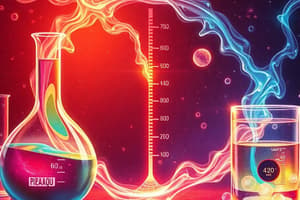Podcast
Questions and Answers
What produces H3O+ ions when placed in water?
What produces H3O+ ions when placed in water?
Acid
What is a proton (H+) transfer reaction called?
What is a proton (H+) transfer reaction called?
Acid-Base Reaction
What term describes a substance that can act as either an acid or a base?
What term describes a substance that can act as either an acid or a base?
Amphoteric
What produces OH- ions when placed in water?
What produces OH- ions when placed in water?
What is a Bronstead Lowry Acid?
What is a Bronstead Lowry Acid?
What is a Bronstead Lowry Base?
What is a Bronstead Lowry Base?
What is a Buffer Solution?
What is a Buffer Solution?
What is Buffer Capacity?
What is Buffer Capacity?
What do you get when you add a proton (H+) to a base?
What do you get when you add a proton (H+) to a base?
What do you get when you remove a proton (H+) from an acid?
What do you get when you remove a proton (H+) from an acid?
What is a Conjugate Acid-Base Pair?
What is a Conjugate Acid-Base Pair?
What are Diprotic Acids?
What are Diprotic Acids?
What is the Hydronium Ion?
What is the Hydronium Ion?
What is an Indicator in chemistry?
What is an Indicator in chemistry?
What is the Ion Product of Water (Kw)?
What is the Ion Product of Water (Kw)?
What are Monoprotic Acids?
What are Monoprotic Acids?
What is the formula for pH?
What is the formula for pH?
What characterizes a Strong Acid/Strong Base?
What characterizes a Strong Acid/Strong Base?
What are Triprotic Acids?
What are Triprotic Acids?
What are Weak Acid/Weak Base?
What are Weak Acid/Weak Base?
Flashcards are hidden until you start studying
Study Notes
Acids and Bases
- Acid: Produces hydronium ions (H3O+) when placed in water.
- Base: Produces hydroxide ions (OH-) when placed in water.
- Brønsted-Lowry Acid: Donates a proton (H+).
- Brønsted-Lowry Base: Accepts a proton (H+).
- Amphoteric (amphiprotic): Substance that can act as both an acid and a base.
- Conjugate Acid: Formed by adding a proton (H+) to a base.
- Conjugate Base: Formed by removing a proton (H+) from an acid.
- Conjugate Acid-Base Pair: Any pair of molecules or ions that can be interconverted by the transfer of a proton (H+).
Acid-Base Reactions
- Acid-Base Reaction: A proton (H+) transfer reaction.
Strength of Acids and Bases
- Strong Acid/Strong Base: Dissociates completely (100%) in water.
- Weak Acid/Weak Base: Dissociates partially (less than 100%) in water.
pH
- pH: Measures the acidity or alkalinity of a solution.
- pH = -log[H3O+]
- Hydronium Ion: H3O+
Ion Product of Water
- Ion Product of Water (Kw): Describes the equilibrium constant for the autoionization of water.
- At 25°C, Kw = 1.0 x 10^-14
Buffer Solutions
- Buffer Solution: Resists changes in pH when small amounts of acid or base are added.
- Common Example: An aqueous solution containing a weak acid and its conjugate base.
- Buffer Capacity: The maximum amount of acid or base that can be added before the buffer stops working.
Polyprotic Acids
- Monoprotic Acid: Can give up only one proton (H+). Example: HCl (Hydrochloric Acid).
- Diprotic Acid: Can give up two protons (H+). Example: H2SO4 (Sulfuric Acid).
- Triprotic Acid: Can give up three protons (H+). Example: H3PO4 (Phosphoric Acid).
- Indicator: Changes color at a specific pH.
Studying That Suits You
Use AI to generate personalized quizzes and flashcards to suit your learning preferences.



